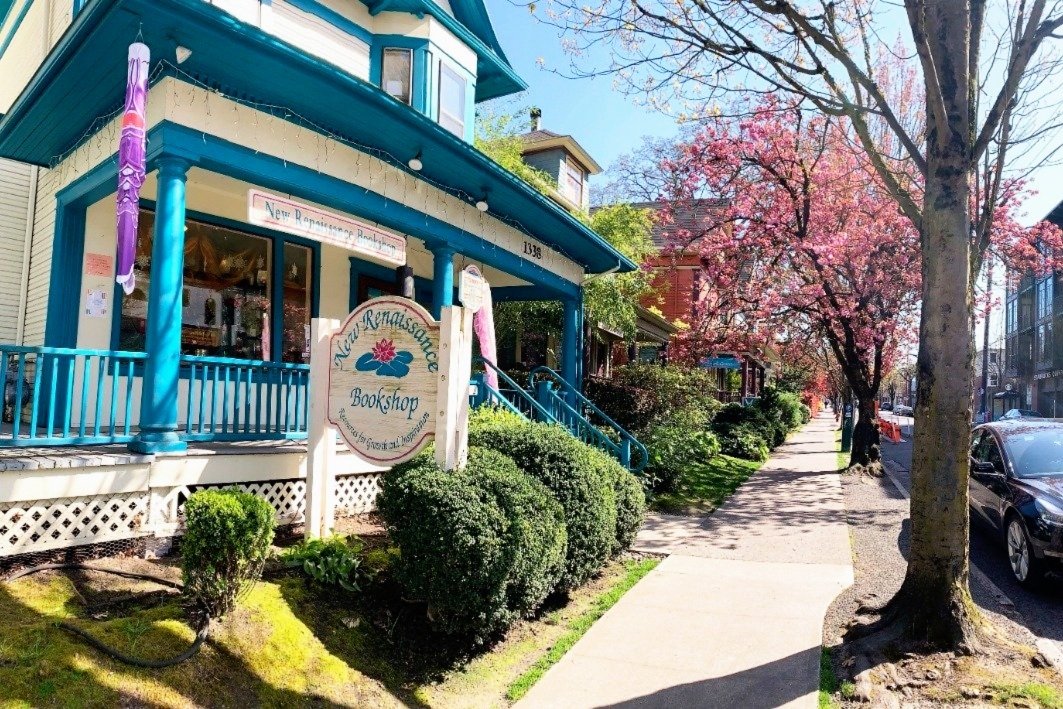
New Renaissance Bookshop
TAKING YOUR BRICK AND MORTAR ONLINE
TIMELINE
PLATFORM
ROLE
TOOLS
3 Weeks
Desktop Website
UX/UI Designer
*Solo Product Designer for this project
Figma
Otter.ai
Miro
THE PROBLEM
New Renaissance Bookshop is a beloved Portland, OR staple and has been known as the “largest metaphysical bookshop in the Pacific North West” for the past 35 years. Offering over 100 different products and services from incense to palm readings, this shop is less of a bookshop like its namesake states, and more of a community.
Pre-Covid, there was no way of purchasing any items online, and there currently technically still isn’t. During Covid, they partnered with Bookshop.org, a book-selling eCommerce site for small businesses, but as previously mentioned- their brick and mortar offers a very wide variety of products, not just books. With the new reality of our world since 2020, NRB worry that even with the addition of Bookshop.org, they’re still falling behind the growing competition in the area.
THE CHALLENGE
Despite the want and need for a more gratuitous and engaging online presence, the business does not have the staffing nor the means to provide full online access to their entire collection. Most items are handmade, unique and one of a kind, made by a variety of vendors, which would add extra layers of difficulty if offering such products online. Other items, such as singing bowls and meditation equipment, require tactile judgement and testing prior to purchasing.
“How might we create an eCommerce site that fits the needs of both the users and this unique business without creating more problems?”
Research
My first approach to researching the problem was to conduct user interviews, market research, and perform a site audit. I also researched indirect local businesses (New Seasons, Little Otsu) to see how they were coping with the changes brought about by Covid, and which ones were successful at staying competitive amidst the pivot.
User Interviews + Site Audit
I conducted 5 user interviews- 2 loyal New Renaissance customers, 2 customers loyal to other local metaphysical shops, and 1 avid online shopper. New Renaissance already has a website, but a barely functioning one. Before I could dive into problem solving their eCommerce issues, I had to compile a list of general website functionality needs first.
I also surveyed 10 users via Google Form to help me better understand metaphysical consumers, and conducted a card sort to compare their behavior to the survey findings.
User Needs
Users wish for more ways to support their favorite local business while social distancing.
Users want to shop on a website they can trust.
Users prefer succinct, sufficient information (including photos) when online shopping.
Audit Insights
No search bar
Confusing, repetitive navigational system
Inability to see specific products and brands the store offers
Some users stated that it “looks somewhat spammy”
Inconsistent links
Events not visible/difficult to sort and find
No sorting options
Inactive buttons
Inability to make a purchase via website in general
Meet June & Nate
I created two target personas based on my : Nate, a local yoga teacher and avid meditating father of two, and June, a doula and local artist. I would refer back to Nate and June often throughout the design process to remember their motivations, goals, and pain points.
Ideate
Based on my research, I began creating user flows that centered around two main actions that were necessary for moving forward- a flow to purchase items (of any kind) online but for in-store pick up, and a flow for booking a reading with a practitioner. Next, I began sketching possible solutions for both the layout design and information architecture.
Solutions
First, I had 3 users experience a lo-fi prototype to test my designs against my assumptions and to look for any key insights I may have missed.
I made changes involving check-out clarity, CTA visibility and verbiage, sorting options and color scheme, then tested a second time with the same 3 users against the current version of the hi-fi prototype.
In order to deliver an MVP within the project timeline, I wanted to focus the final prototype on the following features:
Logical, organized navigational system
Product filters and site breadcrumbs
On site check-out options for books, gift cards, events, and in-store pick up
Check out the demo!
Prototype + Testing
100% of users are saying:
“The website now matches the feel of the store. I would use and trust this website.”
100% of users are saying:
“I’m finally able to support the store in a variety of ways. I’m no longer limited to books or donations.”
Future Iterations
Creating online accounts for the user as well as merchandisers so that customers could contact them to order custom made items.
Work with the owners to re-assess the current design system and logo.
Online event calendar.
Create a “customer spotlight” section to help users feel more connected while shopping online.












